The Timeless Legacy of Omega and the Olympics
As the Paris Olympics are upon us, Omega continues to shape the games with its timing perfection.
Some things just go together. These connections are ingrained in us, programmed by the powers that be to align companies, people, events, and moments in our lives which we cannot shake. College Football Bowl week, there will be Tostitos, thinking of a warm summer day by the pool, it’s a coldcut sandwich and Doritos. Fred Durst — red baseball cap. Daniel Radcliffe will always be Harry Potter, you get the idea.
When I think of the Olympics, I think of those 5 colorful rings, but most importantly (at least in the context of horological journalism) I think of Omega.
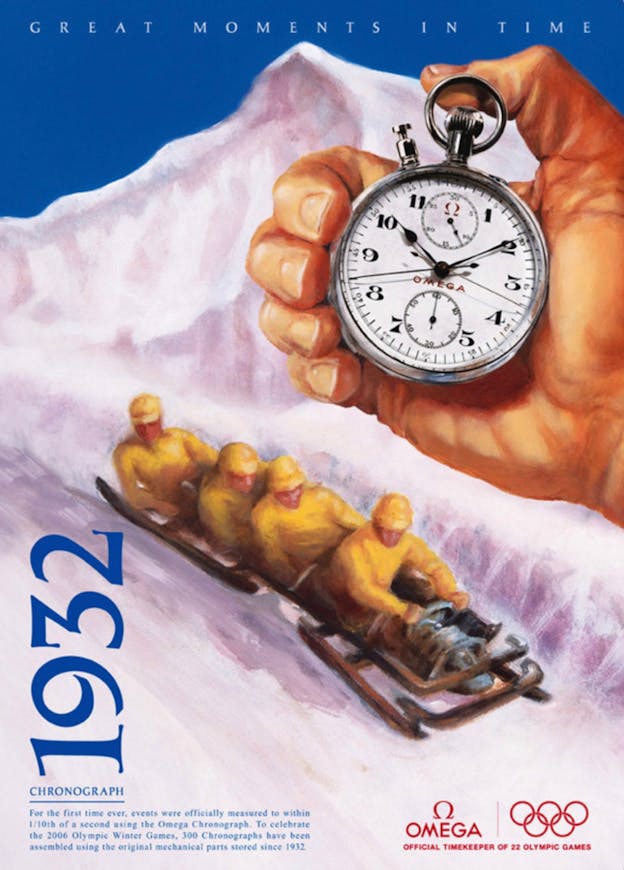
Omega, has a rich history that is deeply intertwined with the Olympic Games. For over a century, Omega has been an integral part of the world’s most prestigious sporting event, serving as the official timekeeper for an unprecedented 31 Olympic Games. Let’s face it — even non-sports enthusiasts watch the Olympics. I don’t care who you are, if Olympic table tennis is not entertaining to you, I suggest a neuropsych eval ASAP.
What is incredible about Omega’s story and partnership with the Olympics, is that they have not just rested on their laurels as the official timekeeper but they have allowed the games to evolve from a once “only-live” event that you read about in the papers to something we can all enjoy from the comfort of our homes. Without this partnership the evolution of the games, especially the televised games we know and love today, would have been nil.
Early Beginnings
The games we see today on television are obviously far from the naked wrestling days of ancient Greece. What is considered, and in some circles debated, as the first modern Olympic games is the 1896 games in Athens. The first Winter Olympics wasn’t held until 1924 in Chamonix and it wasn’t until the 1956 Winter games in Cortina d’Ampezzo, Italy that they were broadcast on television.
Despite Omega earning the title as the official timekeeper of the Olympics in 1932, they got their start in sports timekeeping much earlier. Omega’s journey with sports timing began in 1905, when the brand was entrusted with timing the Gordon Bennett Cup, a prestigious international balloon race. This marked the first time a watchmaker had been involved in sports timing, paving the way for Omega’s future endeavors. The brand’s founder, Louis Brandt, recognized the importance of precision timing in sports, setting the stage for Omega’s future Olympic involvement.
The Olympic Journey Begins (1932)

Omega’s Olympic debut took place at the 1932 Los Angeles Games, where they were responsible for timing the events. This partnership was a natural fit, as Omega’s precision and reliability perfectly aligned with the Olympic values. It wasn’t just the values, but the fact that Omega was able to provide the Olympics with 30 calibrated chronographs, all pocket watches naturally. Each athlete was assigned their own timekeeper who sat at the finish line to make sure they started and stopped the timepiece with the utmost accuracy a human possibly could. And as we recently found out in an article by Jack, humans are not as accurate as we would all like them to be.

These were split-second chronographs (rattrapante) accurate to 1/10th of a second and certified by the Neuchatel Observatory. To put this in perspective, previous watch manufacturers provided chronographs for some of the older games, and they were only accurate to 1/5th of a second. This became so problematic that the Olympic committee wouldn’t even publish the times for fear of inaccuracy and controversy. Only the athletes themselves ever knew the times they clocked.
The 1932 games was also the first time that Chronocinima was unofficially used. The experimental camera was able to track times to the nearest 1/110th, but was never considered an official time due to the fact it took several hours to develop the film and multiple judges to come to an agreement.
At the Winter Olympic Games in 1936 Omega took it one step further and timed the downhill skiing competition by using two chronographs, one at the start and the other at the finish. After the race competing skiers would transport the start times down the hill to calculate the difference. You don’t need to be Einstein to figure out how that method could go awry. This would all be solved at the following Olympic games with the introduction of photoelectric cell technology.
The Birth of Electronic Timekeeping
It’s hard to trust new technology, especially during a time when anything considered electric was as foreign to humanity as a UFO is to us today. It’s like when my mother used to be afraid to put any CD in the cd-rom in fear of it exploding, or the fact that my father believed when all the computers showed “00” as the date, the computer would think it’s the beginning of the time and self-destruct — anyway I digress.
It was 1932 during a controversial finish in the 100 meters between Thomas Tolan and Ralph Metcalfe that the world turned to the electronic Chronocinema.
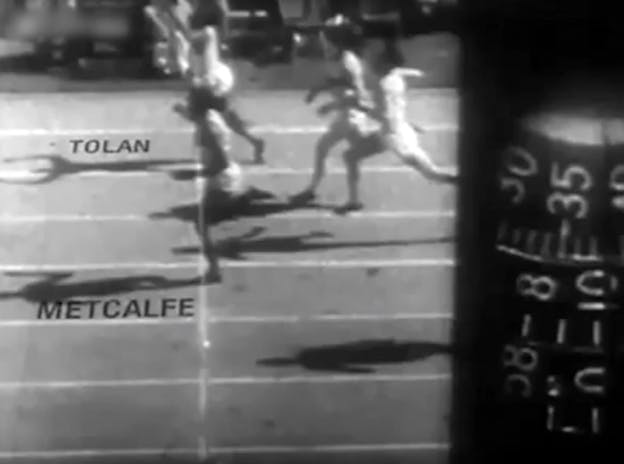
The problem was simple in theory — the times didn’t match what people saw. Both runners clocked a time of 10.3 seconds (this makes me wish I ran back in the 30’s), but according to the judges it appeared Metcalfe crossed the line first. So they brought in the Chronocinema, which recorded the exact moment the finish line was crossed, allowing the judges to see without a doubt which athlete won the race. It turned out Tolan’s Torso was actually the first to completely cross the finish line and he was declared the winner by 5/100th of a second.
By 1948 as technological advances made major leaps, electronic timekeeping really took hold and replaced the majority of humans in Olympic games.

The electronic timing system used in 1948 dubbed the “Magic-Eye” featured a camera synchronized with an electronic starter pistol. This innovative setup utilized a narrow slit, precisely calibrated to the finish line, which would capture the exact moment a competitor crossed the line, interrupting a light beam and triggering the camera shutter. This technology significantly reduced the wait time for official results, now announced within a couple of minutes. A vast improvement over the agonizing hours needed with the Chronocinema.
Initially, the camera served as a supplementary tool for determining final placements, but by the 1952 Helsinki games, it had evolved into the Omega Racend Timer, a trusted official timekeeper. It was during these games that Omega introduced the first electronic chronograph accurate to 1/100th of a second, and not only that… this bad-boy was portable and had a printer built in for immediate results.
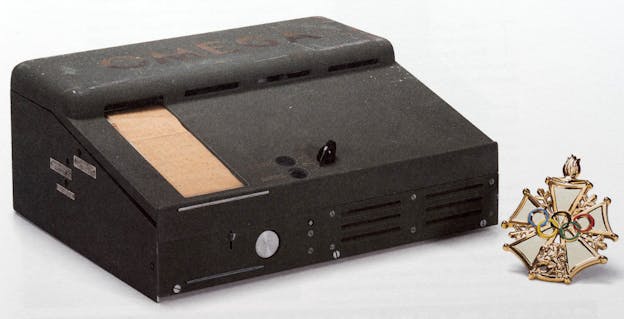
By the time we got to the Melbourne games in 1956 Omega was on a roll. They packed up 2,475 kg of equipment in 42 boxes (for those wondering, this is 5,456 lbs). In one of these packages was one of the most sophisticated pieces of timing technology to date, the Swim Eight-O-Matic. (Please someone invent a time machine so I can go back in time and be the person responsible for naming Omega timing devices from the early part of the 20th century).

The pioneering timing system boasted eight independent electro-mechanical counters, each dedicated to a specific lane and equipped with a numeric display. The starting signal from the pistol triggered the automatic activation of the timers, while timekeepers at the finish line manually halted the counters using portable electric stopwatches, ensuring precise control over the timing process. This hybrid approach blended automated and manual elements to achieve accurate results.
1964 The Moment Television and Sports Became like Peanut Butter and Jelly

The 1964 Omegascope introduced “real time” in televised sports as it superimposed numbers on the bottom of the screen. (along with a little Omega insignia). This also marked the first “fully electronic” games.

By 1968 Mexico City games were now broadcast in color and Omega integrated its timing system for broadcasts. As well, after a “technicalities” in previous swimming events Omega deployed the first electronic touch pads for the pool, eliminating any human error.
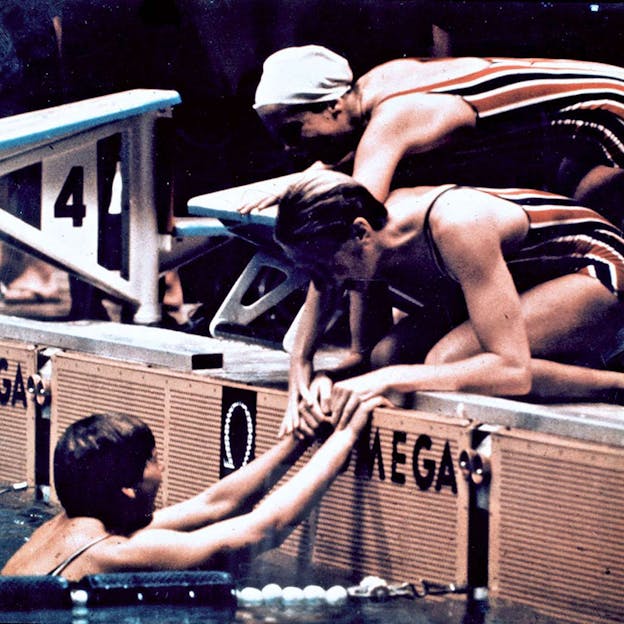
1968 is also when Omega Photosprint was introduced. This was the enhanced version of the Racend Timer and the first time it was accepted as accurate enough to determine official results. When the runners crossed the finish line and passed through the same tiny vertical opening as previous models, however, it was now linked with a camera that could develop the image in under 30 seconds. The Photosprint would go on to record 10 of the 31 world records achieved that summer.
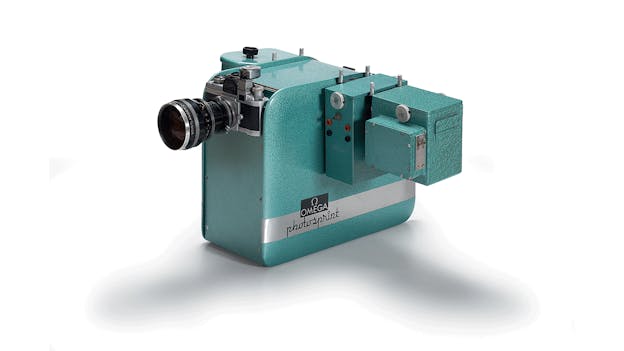
And then we entered the 70’s and 80’s and as any good watch historian knows, we hit the quartz crisis. As money slowed, Omega looked at its balance sheet and needed to make a decision about its involvement in sports timing and the Olympics specifically. As I noted earlier the shipments kept getting bigger and bigger, and in turn costlier.
As the story goes it was Nicolas G. Hayek Sr, the head of ASUAG-SSIH Group aka the godfather of the modern swiss watch landscape had a decision to make after two senior members approached him and suggested they pull out of working with the Olympic games. According to a 2006 interview he emphatically explained that under no circumstances would Omega ever give up their position as the official timekeeper of the Olympics.
“‘You want me to close down this department, let the people go, lose a tremendous amount of know-how and leave the way clear for our competitors?” He said to the senior staff members. “If we do that and then five years later suddenly decide we want to go back, we will be left with nothing.’ Timekeeping is an incredibly dynamic message for the Swiss watch industry, so incredible you can’t imagine. Sport is linked to emotion. It has an amazing impact on people. And it is right that Omega should do the Olympic Games. Omega has contributed a huge amount to the development of sports timekeeping since the very beginning. We should never, under any circumstances give up on our involvement.”
Modern Timekeeping and the Olympics as We Know it.
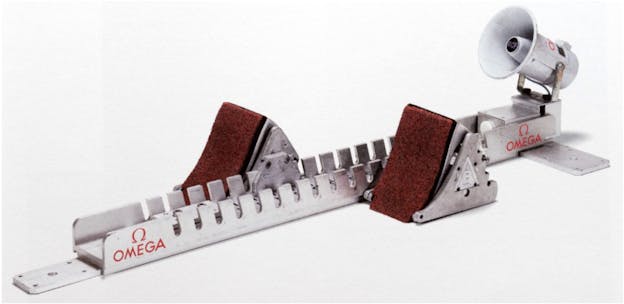
Fast forward to 1984, and Omega introduced the false start detection system for the first time. To me this is one of the wildest advancements that Omega came up with in its century plus of sports timekeeping innovations. It did not run on any visual queue. It was triggered by pressure. Omega placed sensors in the blocks and when 29kg of pressure (for men — 27kg for women) was issued against the block, it would show on a graph, which allowed the judges to determine whether or not the runner had moved within the 0.1 second post start window. This coupled with the installation of loudspeakers behind each block, allowed for the most accurate and fair race starts in the history of sports.
With all this tech, it was only a matter of time before Omega brought in the big guns. Computers. Sports timekeeping was no longer about just recording and projecting times, but now it was about storing and projecting images, videos and key statistics to the judges, announcers and most importantly the public. This revolutionized the way we watch and experience sports.
It was the Soul games in 1988 when Omega used its video matrix board that measured 14m x 9m and accompanied by special scoreboards that were mounted on top of cars which drove around as the boards projected live times to the cheering spectators.
By 1992 Omega dropped another innovation. This time with an even more electric name (pun 100% intended). The Scan’O’Vision was a digital system first used in Albertville, and was able to measure times to the nearest 1/1000th of a second.
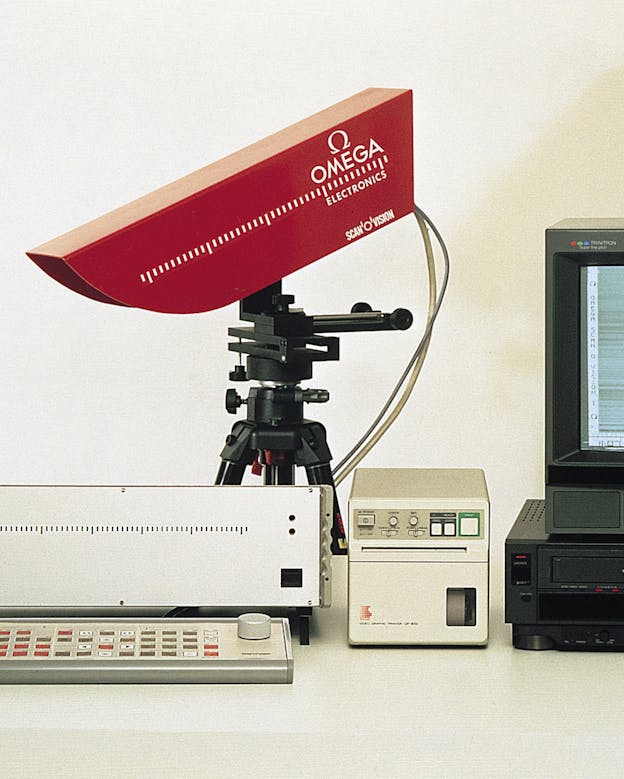
The Scan’O’Vision camera captured images featuring distinctive linear patterns, a deliberate design element rather than a technical glitch. These lines are a visual representation of the sine waves (this one is making my HS physics brain quiver) generated by alternating currents, typically imperceptible to the human eye. The camera’s electronic capabilities rendered them visible, with each vertical line signifying a discrete time interval, influenced by the local power grid’s frequency. The fluctuations in light intensity caused by the alternating currents are precisely what create the unique patterns visible in the photo finish images.

Then between 96 and 2004 Omega took a bit of a backseat to SMH Group’s other brands, despite still running all the clocks for the actual games. Then in 2006 Omega came back with a vengeance, landing in Torino with 220 tons of equipment. That’s not what’s impressive if you ask me, and I know you didn’t, but I will tell you what is impressive. They recorded 105,510 times, 10,891 speeds, 72,122 scores and 2,582 distances… and wait for it… not one single controversy or challenge. Omega was recording a time, distance, speed or score every 4 seconds during those games. This, my horological brethren, is the definition of perfection.
The evolution of Omega’s technology since the early 2000’s is absolutely remarkable. From GPS tracking for marathon runners, data collectors in athletes shoes, to the updated touch boards in the pool, which was able to give us the incredible double stroke come-from-behind win of Michael Phelps in the 100m butterfly in 2008.
Since 2010, the starting gun also got a makeover. This was for a myriad of reasons, first, the world has changed and traveling with a blank pistol internationally became more of a headache than necessary, as well, according to my 7th grade science teacher, light always travels faster than sound, and in turn, the closest athlete to the pistol consistently had a slight advantage. Now, when the starter pulls the trigger on a device that looks closer to a weapon in Star Wars, the gun simultaneously sounds on every athlete’s starting block.
2012: When Accuracy Takes on a Whole New Meaning.

Alright team, we are almost nearing the end (for now) regarding Omega’s technical innovations in sports timekeeping. However, I like to think a line was drawn in the sand in 2012 when the games took over London. Enter… wait for it… the Quantum Timer. (Whoever makes these names for Omega’s Olympic timers needs to move to their watch department). We went from mechanical split second chronographs in the 30’s to electronics in the 60’s and now we have the use of atomic timing.
This evolution wasn’t a small leap, this was a long jump into the future of time keeping. It was accurate to 1/1,000,000th of a second providing the most precise times in Olympic history. This meant it was 5 times more accurate than previous timers.
The device’s remarkable accuracy was made possible by the integration of a Micro Crystal element, otherwise known as HF quartz and 16 autonomous timekeeping modules, all housed within a single unit. This innovative configuration enabled the simultaneous tracking of 16 distinct running times. Furthermore, this setup allowed for seamless data transmission, facilitating real-time updates to scoreboards and television displays, and ensuring that precise timing information was readily accessible to all.
The 2016 Rio Olympics marked the unveiling of the next-generation Scan’O’Vision, capable of capturing a staggering 10,000 digital frames per second. This technological leap also brought enhanced low-light performance, resulting in significantly reduced image noise and unparalleled clarity – a remarkable achievement considering the sensor’s extremely brief 1/10,000th-of-a-second readout window. Concurrently, the Omega Photocell underwent a significant upgrade, integrating four cells into a single device to enable more precise tracking of athletes’ movements at the finish line, ensuring accurate winner determination.
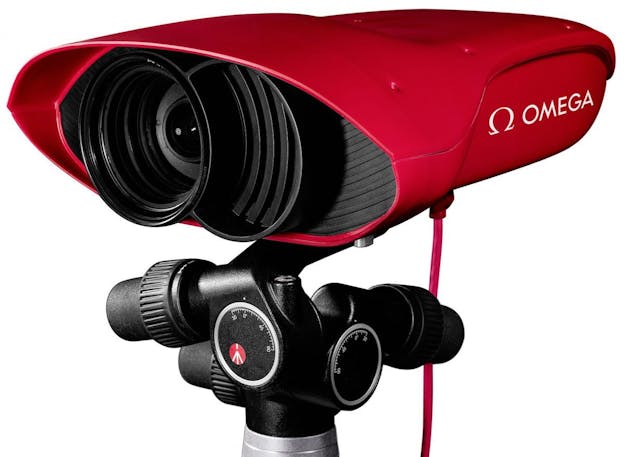
Fast-forward to the 2018 Pyeongchang Winter Olympics, where Omega introduced a suite of wearable innovations to track the trajectories of skiers, skaters, snowboarders, and ski jumpers. This wealth of data was transmitted in real-time, creating an immersive, video game-like experience for viewers.
Paris 2024 and Beyond

If it is not clear by this point — Omega has continued to move the needle forward on sports timekeeping, revolutionizing the way we not only track and determine winners, but the way we experience sports as a whole. That is no different as we look forward to the start of the 2024 games in Paris.
They plan to bring along 550 timekeepers deploying 350 tons of equipment to track 32 sports, which is far off from the one watchmaker with a suitcase of 30 chronographs that originally landed at the 1932 Olympics. Packed away in the 350 tons are individual sensors for each athlete that tracks more than 2,000 data points per athlete per second.
When these athletes train their entire lives for just 10 seconds, Omega is committed to making sure they provide the most accurate timing systems in the world. This plays into the storytelling of sports, putting into context the entire athlete’s performance, and will be communicated to not just the athletes but the viewers.
Learn more about the recent innovations for the 2024 Paris Olympics here.
(All images are from Omega)

